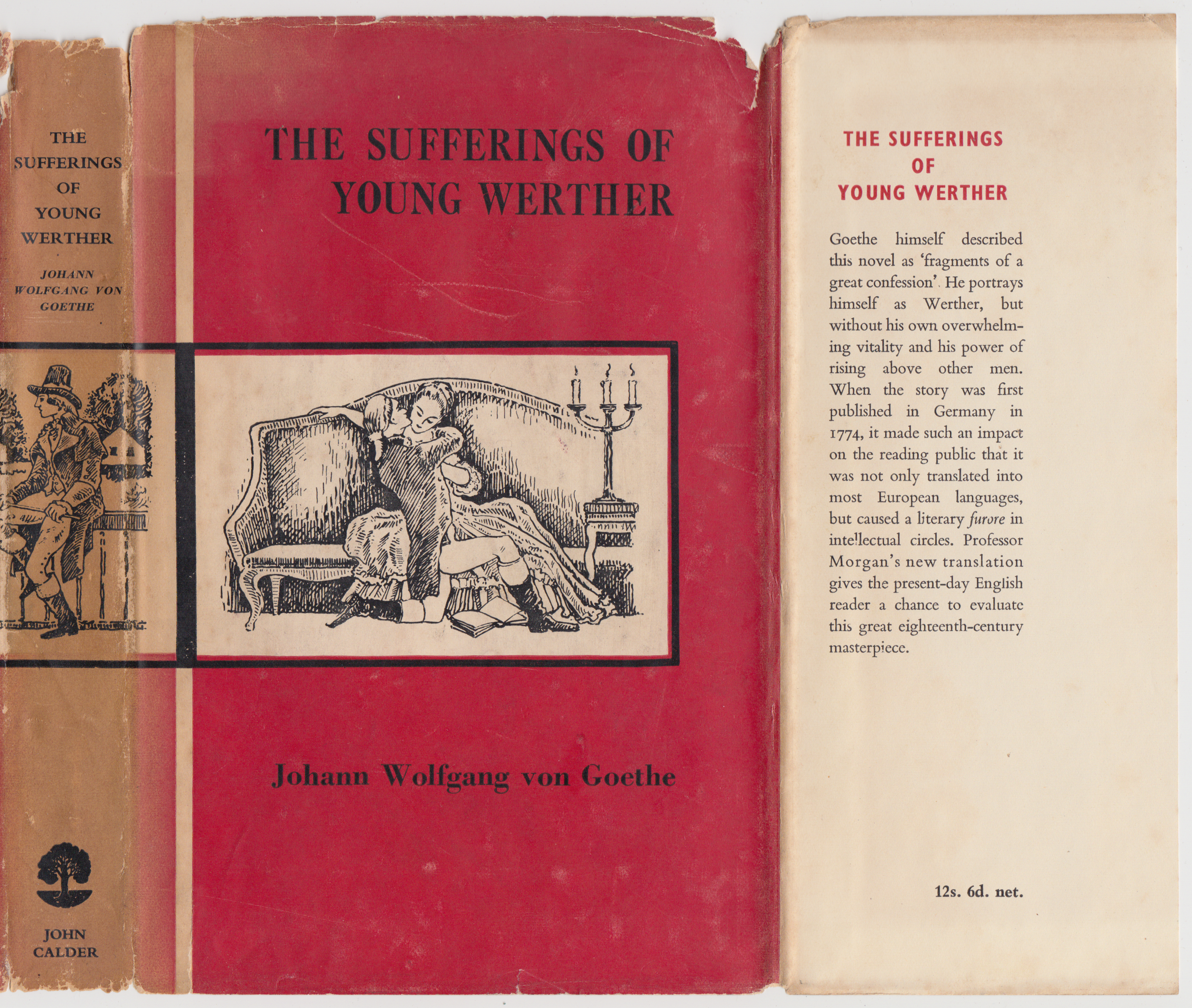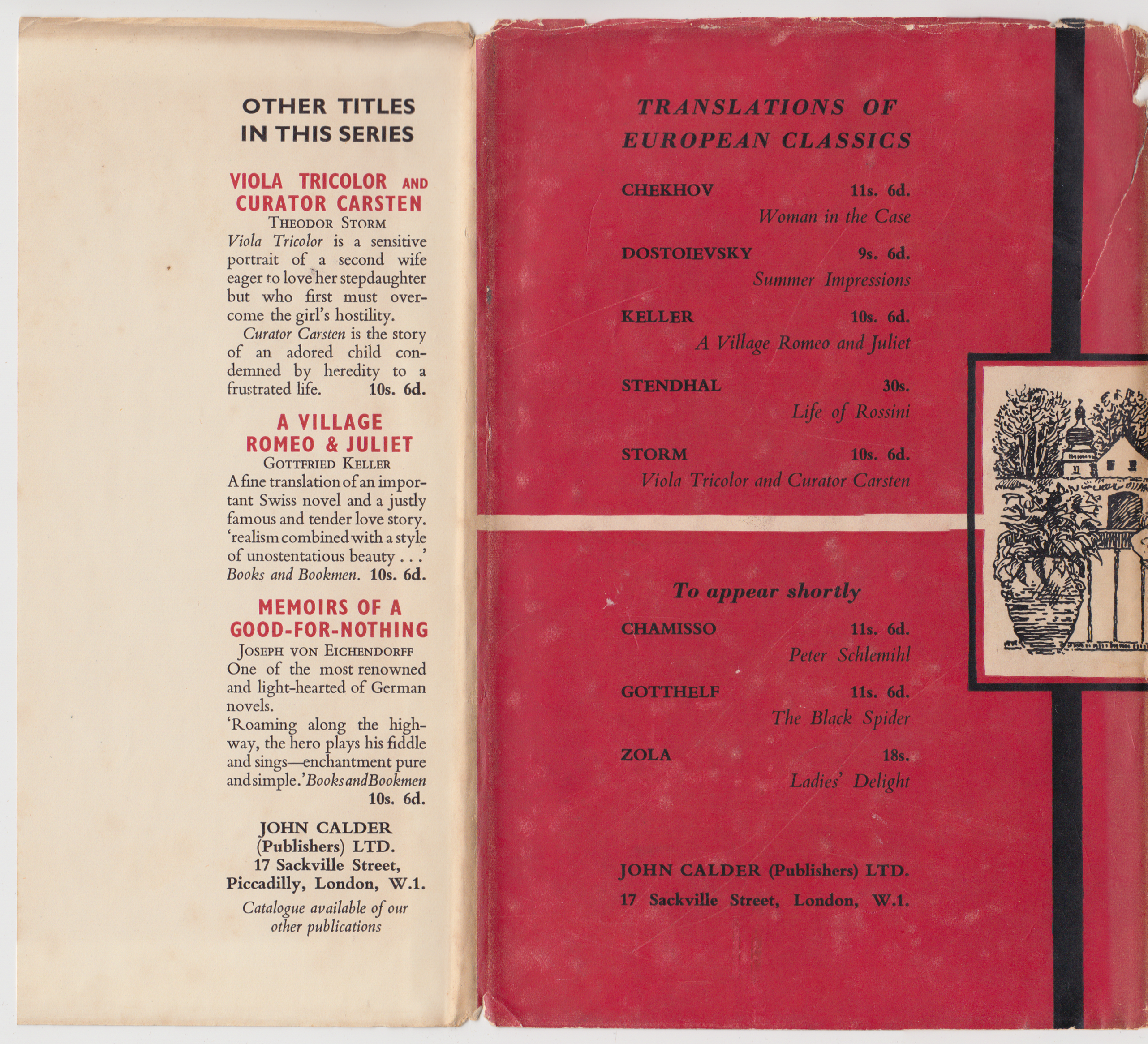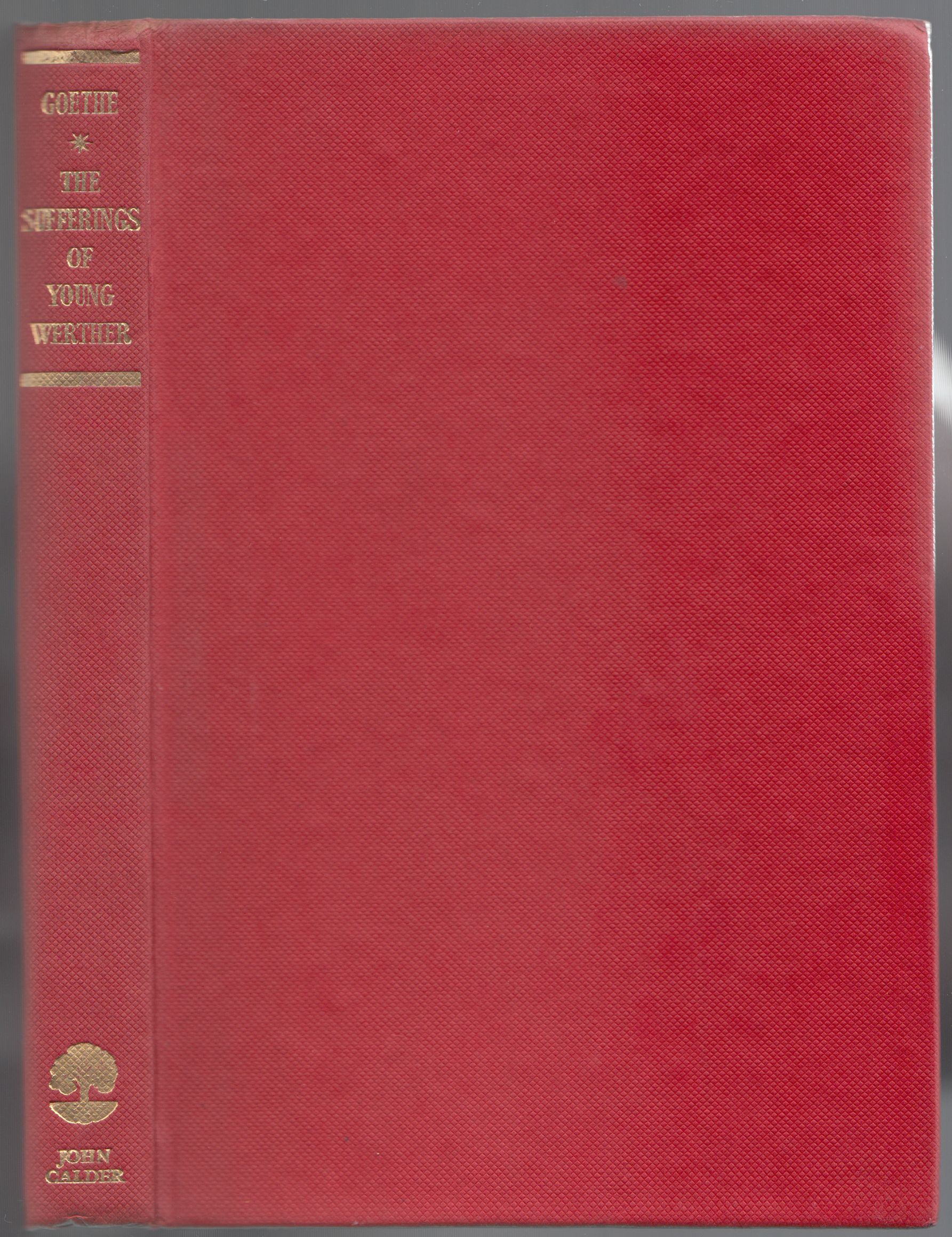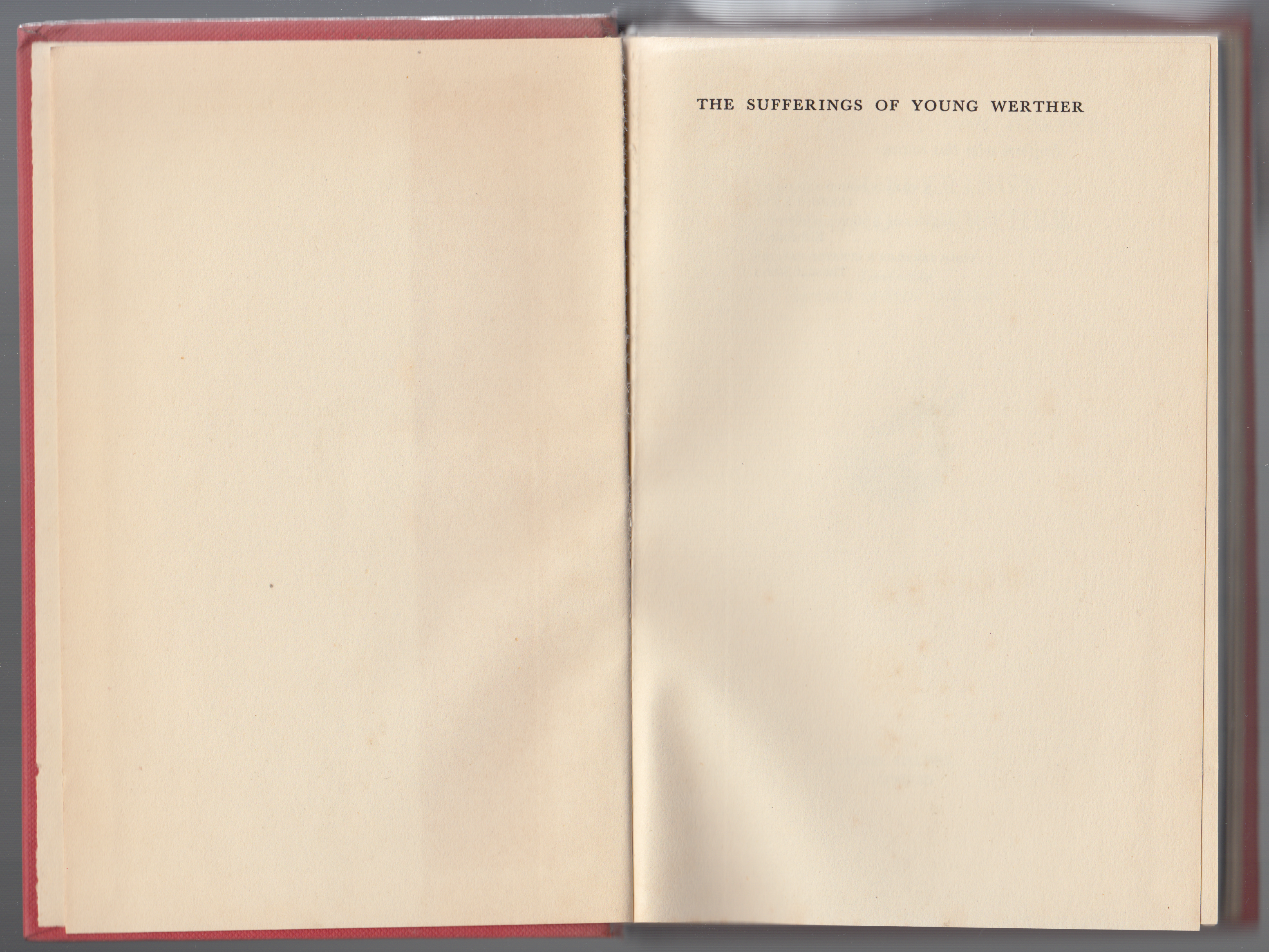aka/ Translations of European Classics
John Calder Ltd. (London, UK)
Series dates: 1954-2000
Size: 7.5″ x 5″
John Calder began publishing in 1949 and the firm continues today as Calder Publishing, a part of the firm Alma Books. Calder’s stable of authors includes nineteen Nobel Literature and three Nobel Peace prize winners. Translated works dominated Calder’s publications in the 1950s and 1960s, as well as publications that US publishers avoided during the McCarthy era in the U.S. In the late 1950s, Calder began to develop a large group of avant-garde authors, including Samuel Beckett and William S. Burroughs.
An advertisement (Times Literary Supplement, March 12, 1964) advertises recent Calder publications is below. “Calder Modern Authors” (with Beckett as “No. 1”) seems to suggest a series, but there are no entries in WorldCat (or elsewhere) using that series name. The Jupiter series is actually Jupiter Books, a paperback Calder series. Both examples suggest Calder’s tendency to be rather loose with their book series.
The company became Calder and Boyars in 1963, then reverted to its original name in 1975. In 2007 Calder was acquired by Oneworld Classics (a collaboration between Alma Books and Oneworld Classics). In 2012 Alma Books took over Calder and Oneworld Classics. (source) Alma continues to publish many reprint titles, including many originally issued by Calder.
John Calder’s series European Classics, sometimes referred to as Translations of European Classics, is a bit difficult to pin down given the generic series name, a varying name (sometimes prefaced with “Translations of…”, the lack of series name on the books (and the wrong name on the jackets) and the fact that some titles are listed as both part of the series and not part of the series on different dust jackets from series titles and other Calder publications. I can account for 30 titles (detailed below).
It’s possible that 1953 was the start of the series, with Chekhov’s The Woman in the Case, which is the first title in the series. 1953 editions of this title appear under the Spearman and Calder imprint (Spearman Ltd. and Calder had a co-publishing agreement until about 1954). But the manuscript documentation for Calder’s firm seems to suggest that a 1954 second printing of this Chekhov title may have been the first of Calder’s European Classics series.
Documenting titles in the European Classics is a challenge. I’ve found a few jacket catalogs (see scans below), but have not found any series lists in advertisements or other sources. One seemingly exhaustive bibliography of Calder’s publications (In Defence of Literature: For John Calder by Howard Aster & Amy Land, 1977) details just about every detail about every Calder title except for series information, which is odd and disappointing.
Many of the titles below are not listed under the series name on WorldCat, but I’ve seen some evidence (dust jacket lists, or references on the internet) that the book is part of the series. Other titles are listed as in the series on WorldCat, but I can’t find any other documentation suggesting the titles are part of the series. Calder did not seem that concerned about a highly controlled series (like, say the Modern Library) with a clear demarcation between the series and other Calder books.
Some of these titles were issued in paperback as part of the Calderbooks series.
In all, my count of titles in Calder’s European classics is 30 titles. One, Three German Classics (1966), contains one title (Village Romeo) previously published alone in the series in 1955.
1953
The Woman in the Case, and Other Stories, by Anton Pavlovich Chekhov; translated by April FitzLyon & Kyril FitzLyon (London: Spearman and Calder) (reprint, 1954). The 1953 Spearman and Calder issue does not seem to have been in the series, with multiple copies for sale on the internet with a non-series jacket. It’s probable that the 1954 reprint under the Calder imprint alone is in the series. Spearman Ltd. and Calder had a co-publishing agreement until about 1954. (source) (reprint, 1954)
1955
A Village Romeo and Juliet, by Gottfried Keller; Translated by Paul Bernard Thomas
Green Henry, by Gottfried Keller; translated by A.M. Holt. (source) (reprint, 1960, 1970)
Memoirs of a Good-for-Nothing, by Joseph von Eichendorff; translated by Bayard Quincy Morgan (reprint, 1966)
Summer Impressions, by Fyodor Dostoyevsky; Translated by Kyril FitzLyon
1956
Life of Rossini, by Stendhal; Translated by Richard N. Coe (reprint, 1970, 1985)
Viola Tricolor & Curator Carsten, by Theodor Storm; translated by Bayard Quincy Morgan and Frieda M. Voigt (reprinted, 1963)
1957
Peter Schlemihl, by Adelbert von Chamisso; translated by Leopold von Loewenstein-Wertheim. (reprint, 1970)
Mozart’s Journey to Prague, by Eduard Mörike; translated by Leopold von Loewenstein-Wertheim. (reprint, 1964, 1976, 1980, 1985)
The Walk and Other Stories, by Robert Walser; translated by Christopher Middleton
The Sufferings of Young Werther, by Johann Wolfgang von Goethe; translation by Bayard Quincy Morgan (reprint, 1964, 1966, 1976)
Ladies’ Delight, by Émile Zola; Translated by April FitzLyon
Metamorphoses, by Ovid; translated by Rolfe Humphries
1958
The Art of Love, by Ovid; translated by Rolfe Humphries
The Black Spider, by Jeremias Gotthelf; Translated by H.M. Waidson (reprint, 1965, 1980)
The Jew’s Beech, by Annette von Droste-Hülshoff; translated by Lionel Thomas and Doris Thomas (reprint, 1963, 1967)
1959
The King’s Bride, by E.T.A. Hoffmann; translated by Paul Turner
A Slight Misunderstanding, by Merimee; translated by Douglas Parmée. (reprint, 1963)
The Three-Cornered Hat, by Pedro Antonio de Alarcón; translated by H.F. Turner.
Wife for Sale, by Anton Pavlovich Chekhov; translated by David Tutaev
1960
The Heretic of Soana, by Gerhart Hauptmann; translated by Bayard Quincy Morgan
Kindred by Choice, by Johann Wolfgang von Goethe; translated by H.M. Waidson (reprint, 1961, 1966, 1976)
Undine, by Friedrich de La Motte-Fouqué; translated by Paul Turner (reprint, 1966)
1962
Martin Salander by Gottfried Keller; translated by Kenneth Halwas. (source (reprint, 1963, 1964, 2010)
1966
Three German Classics: Immensee by Theodor Storm, Lenz by Georg Büchner, A Village Romeo and Juliet by Gottfried Keller (reprint, 1985)
1970
Travels in the South of France, by Stendhal; translated by Elisabeth Abbott (reprint, 1971)
1973
The Sad Geraniums, and Other Stories, by Wolfgang Borchert (reprint, 1974)
1977
Wilhelm Meister, Vol 1: Books 1-3, by Johann Wolfgang von Goethe; translated by H.M. Waidson
1978
Wilhelm Meister, Vol. 2: Books 4-6, by Johann Wolfgang von Goethe; translated by H.M. Waidson
1979
Wilhelm Meister, Vol. 3: Books 7-8, by Johann Wolfgang von Goethe; translated by H.M. Waidson
A few dust jacket scans found on the internet (not in my collection) and used to identify some of the titles in the series are below. The title on the top left (The Black Spider) is from 1958. The title on the top right (Wife For Sale) is from 1959. Both have titles in the lists that are not listed as part of the series on WorldCat. The Ovid titles, for example, appear as series titles on earlier series jackets, but then appear in the 1977 scans (below) below the list of European Classics titles as “Other Titles of Interest” (suggesting they were not in the series).
 |
 |
The front and back jacket flaps from a 1977 Calder edition of Wilhelm Meister (8 books in 3 volumes) published by Calder. The rear flap (right) lists other Calder series, including German Writing in Translation, which contains titles that also appear on the European Translations series list.
 |
 |
Series jackets through the 1950s and early 1960s had a common layout, with varying jacket colors, and unique illustrations, many by Hellmuth Weissenborn. A variation on this jacket design was used as late as 1970. The illustrations wrapped around the jacket from the front, over the spine, to the back of the jacket. This 1957 (first) printing of The Sufferings of Young Werther by Johann Wolfgang von Goethe was translated by Bayard Quincy Morgan (and reprinted in 1964, 1966, and 1976).
The jacket spine, front and front jacket flap (which describes the book and includes a price) do not include the series name.
The back of the jacket provides the only indication of the series name, and it’s not even the correct name, which is European Classics. Five titles are listed, with three forthcoming. The rear jacket flap lists three more titles in the series.
The cloth binding in red has gold typography:
The half-title page:
“Uniform with this edition” lists three more series titles, facing the title page.
“First published in this translation from the German in 1957 by John Calder [Publishers] Limited, 17 Sackville Street, London, W.I.”








